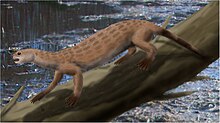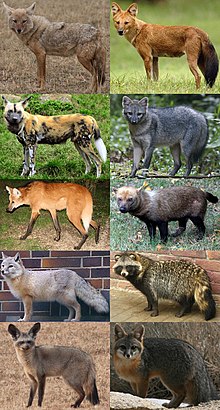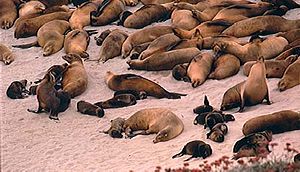Check out this highly adorable video of some grey seals on vimeo (I don't endorse petting/approaching seals btw). On fb my friend said : "So cute! They're like the dogs of the ocean." Now I want to use the second sentence; They're like the dogs of the ocean... as a springboard to look at how the comparison, apt as it is, does betray a certain tendency on our part when describing critters of the ocean. What I mean is a commonality of appearance or habit to some well known land-lubbing critter- given to the more alien marine critter. Think about canned tuna- the chicken of the sea- or even common names like elephant seal, sea lion, sea cow. This ocean-land doppelganger pattern even extends into the middle ages when it was believed a marine bestiary existed that matched counterpart to land animals.
And as terrestrial based creatures ourselves it makes sense that humans have often compared marine critters to land ones due to familiarity. But when viewed through the lens of other parameters- evolutionary history, diversity, abundance- this persistent land based bias in comparing marine critters to terrestrial ones does fall down a bit for me. Let us compare dogs against seals with regards to some perameters that short-circuit this bias.
Evolutionary History- Pinnipeds- walrus (family Odobenidae), true seals (family Phocidae), and eared seals; sea lions; fur seals (family Otarriidae). While traditionally viewed as forming a diphyletic group, arising from two ancestors, recent molecular evidence supports a monophyletic origin (singel ancestor) for pinnipedia with the various groups splitting off later (Berta, A. 2009). And how far back does the family go? Well it appears mammalian carnivorans didn't waste much time getting their feet wet after predaceous marine reptile went extinct. Pinnipeds appear to have split from other carnivorans about 50 mya and we have several putative species showing aquatic adaptations such as Puijila and Enaliarctos, both predators from about 21-24 mya. Of the two Enaliarctos was more firmly dedicated to an aquatic existence.
So give or take a few million years we really start seeing animals that would have appeared very similar to modern seals by around 20 mya.
How far back do dogs go? Dog like carnivores (caniformes) split off from cat like carnivores (feliformes) about 50 mya and the first truly dog-like critters date to about 40 mya, guys like
Prohesperocyon wilsoni. Three main lineages diverged about 34 mya- Hesperocyoninae, Borophaginae, and Canidae- but only one group survived to the present the Canidae. And we really don't see this group asserting itself until about 9-10 mya. So although dog-like animals go back pretty far it is not until relatively recent that we see dogs of the fox/wolf type familiar today. In terms of species there are about 38 species give or take a few here or there.
All in all though it appears that pinniped evolution and canid evolution have quite comparable trajectories into deep time. Hard to really assert that one group predates another. But what about species diversity? Wikipedia claims about 33 species of pinnipeds and about 36 species of dogs- but we know how contentious taxonomic issues can be and new species/subspecies are still being found. But again comparing the two groups in terms of species diversity is also a bit of a wash- if there are more dog species it is not by a high count.
Of course diversity in terms of size/form is another parameter we can look at. As pictured on the left dogs do come in a wide variety of shapes and sizes- but all are immediately recognizable as dogs. They range in size from the 1.5 kg fennec fox to the robust timber wolf at 80 kg. But this 78.5 kg weight differential is paltry compared to the weight differential of 3155 kg between a 45 kg Baikal seal and a 3200 kg southern elephant seals (also largest carnivoran of all time?).
What about biomass comparisons? One way to compare different groups is by looking at how ubiquitous they are in terms of the earth's biosphere. If you were to weigh the mass of all the earth's pinnipeds against all the earth's canids which group would dominate? I know what you are thinking- surely domestic dogs will tip the scale in favor of canids- and I would have to agree. A 2001 estimate suggested the world population of domestic dogs at 400 million. But, for arguments sake, let us exclude domestic dogs which have benefited from cohabitation with man (and vice versa), and only look at wild populations. Ringed seals are thought to number about 1 million individuals and are the most widespread and common of Arctic seals. In Antarctica the Weddel seal is the most abundant seal and it is estimated to have a population of about 800,000 individuals- plus it is big, growing to about half a tonne. Now even just counting these two seals are there any wild canid species that get anywhere close? Coyotes in North America are probably one of the more abundant wild canids but I can't find any good data on numbers and they are pretty small compared to seals. It would be interesting to get a number on wolf populations prior to the widespread eradication campaigns as they have such a wide geographical range. Here is a link to extant wolf populations by country. I would not be surprised if there was at one point more than 1 million wolves worldwide prior to the advent of agriculture/domestication. But this appears to be the pattern for most wild canids- small size, restricted range or large size but reduced numbers/range. In addition to seals I mentioned earlier California sea lions have been increasing in number since 1975 and most estimates place the population at roughly a quarter million individuals. Likewise grey seals have also been increasing as well.
So canids and pinnipeds are quite comparable to one another in terms of depth of evolutionary history, species count, and diversity of form. But pinnipeds steal the show when it comes to size variability and gross biomass of naturally occurring wild stock. Can we really say it is a dog's world? Not when it comes to naturally occurring, evolving populations where seals have the upper hand (flipper) in terms of size range, commonality, and biomass.
Cheers!!
 |
| 12th century |
Evolutionary History- Pinnipeds- walrus (family Odobenidae), true seals (family Phocidae), and eared seals; sea lions; fur seals (family Otarriidae). While traditionally viewed as forming a diphyletic group, arising from two ancestors, recent molecular evidence supports a monophyletic origin (singel ancestor) for pinnipedia with the various groups splitting off later (Berta, A. 2009). And how far back does the family go? Well it appears mammalian carnivorans didn't waste much time getting their feet wet after predaceous marine reptile went extinct. Pinnipeds appear to have split from other carnivorans about 50 mya and we have several putative species showing aquatic adaptations such as Puijila and Enaliarctos, both predators from about 21-24 mya. Of the two Enaliarctos was more firmly dedicated to an aquatic existence.
 |
| Puijila. wiki |
So give or take a few million years we really start seeing animals that would have appeared very similar to modern seals by around 20 mya.
 |
| Enaliarctos. Evolution of Mammals |
How far back do dogs go? Dog like carnivores (caniformes) split off from cat like carnivores (feliformes) about 50 mya and the first truly dog-like critters date to about 40 mya, guys like
Prohesperocyon wilsoni. Three main lineages diverged about 34 mya- Hesperocyoninae, Borophaginae, and Canidae- but only one group survived to the present the Canidae. And we really don't see this group asserting itself until about 9-10 mya. So although dog-like animals go back pretty far it is not until relatively recent that we see dogs of the fox/wolf type familiar today. In terms of species there are about 38 species give or take a few here or there.
All in all though it appears that pinniped evolution and canid evolution have quite comparable trajectories into deep time. Hard to really assert that one group predates another. But what about species diversity? Wikipedia claims about 33 species of pinnipeds and about 36 species of dogs- but we know how contentious taxonomic issues can be and new species/subspecies are still being found. But again comparing the two groups in terms of species diversity is also a bit of a wash- if there are more dog species it is not by a high count.
Of course diversity in terms of size/form is another parameter we can look at. As pictured on the left dogs do come in a wide variety of shapes and sizes- but all are immediately recognizable as dogs. They range in size from the 1.5 kg fennec fox to the robust timber wolf at 80 kg. But this 78.5 kg weight differential is paltry compared to the weight differential of 3155 kg between a 45 kg Baikal seal and a 3200 kg southern elephant seals (also largest carnivoran of all time?).
What about biomass comparisons? One way to compare different groups is by looking at how ubiquitous they are in terms of the earth's biosphere. If you were to weigh the mass of all the earth's pinnipeds against all the earth's canids which group would dominate? I know what you are thinking- surely domestic dogs will tip the scale in favor of canids- and I would have to agree. A 2001 estimate suggested the world population of domestic dogs at 400 million. But, for arguments sake, let us exclude domestic dogs which have benefited from cohabitation with man (and vice versa), and only look at wild populations. Ringed seals are thought to number about 1 million individuals and are the most widespread and common of Arctic seals. In Antarctica the Weddel seal is the most abundant seal and it is estimated to have a population of about 800,000 individuals- plus it is big, growing to about half a tonne. Now even just counting these two seals are there any wild canid species that get anywhere close? Coyotes in North America are probably one of the more abundant wild canids but I can't find any good data on numbers and they are pretty small compared to seals. It would be interesting to get a number on wolf populations prior to the widespread eradication campaigns as they have such a wide geographical range. Here is a link to extant wolf populations by country. I would not be surprised if there was at one point more than 1 million wolves worldwide prior to the advent of agriculture/domestication. But this appears to be the pattern for most wild canids- small size, restricted range or large size but reduced numbers/range. In addition to seals I mentioned earlier California sea lions have been increasing in number since 1975 and most estimates place the population at roughly a quarter million individuals. Likewise grey seals have also been increasing as well.
So canids and pinnipeds are quite comparable to one another in terms of depth of evolutionary history, species count, and diversity of form. But pinnipeds steal the show when it comes to size variability and gross biomass of naturally occurring wild stock. Can we really say it is a dog's world? Not when it comes to naturally occurring, evolving populations where seals have the upper hand (flipper) in terms of size range, commonality, and biomass.
 |
| Sascha Grabow |
Cheers!!

